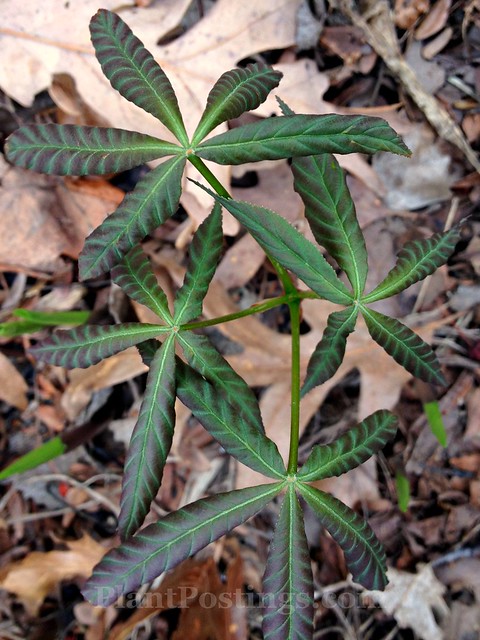
Last spring, I noticed an interesting seedling plant at the edge of a garden bed. The leaves unfurled in mid-April, just as the Lilies-of-the-Valley (Convallaria majalis) surrounding it were poking through and about to bloom.
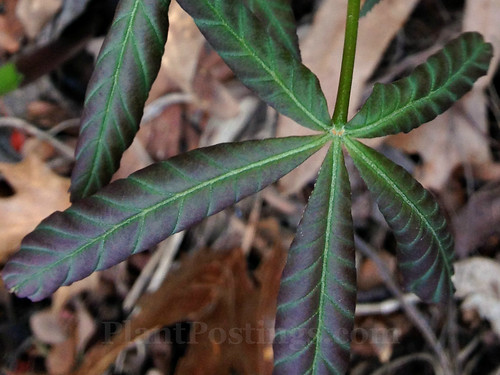
It became clear that this was some type of Buckeye (Aesculus spp.). But which one? Seven species of Buckeye are native to North America, according to the Arbor Day Foundation. I posted a photo of the foliage to a plant identification Facebook group I belong to, but there was no definitive answer.
I'm thinking the variegated coloring of the foliage is a clue? Some suggestions were Red Buckeye (A. pavia), Ohio Buckeye (A. glabra), or even Horse-Chestnut (A. hippocastanum), which is native to the Balkans and Southeast Europe but widely cultivated in temperate zones. Someone mentioned this little tree could be a hybrid.
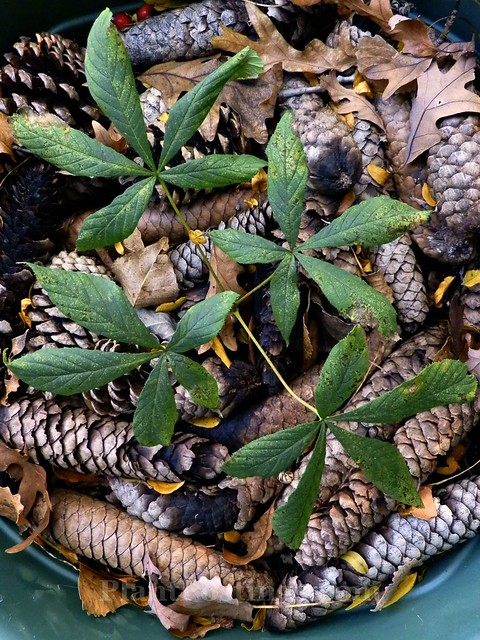
Because I considered it a highly desirable gift from a visiting squirrel or some other garden critter, I potted up the tree, and then tended and observed it throughout the growing season. I placed pine cones around it to serve as mulch and to discourage digging by cats and rodents.
While I wanted to keep the tree, I decided its ultimate garden placement would depend on the species--the largest Buckeyes are tall trees, while the smallest are shrub-size.
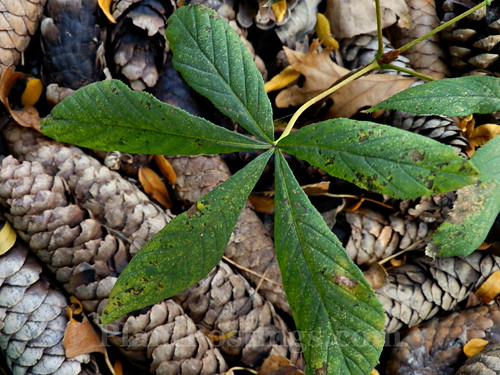
Somewhere along the way I ran across information about Bottlebrush Buckeye (A. parviflora), and began to wonder if this was its identity. As spring faded to summer, and then to autumn, two characteristics of Bottlebrush Buckeye were evident with my little tree. First, the leaves showed signs of a light leaf scorch.
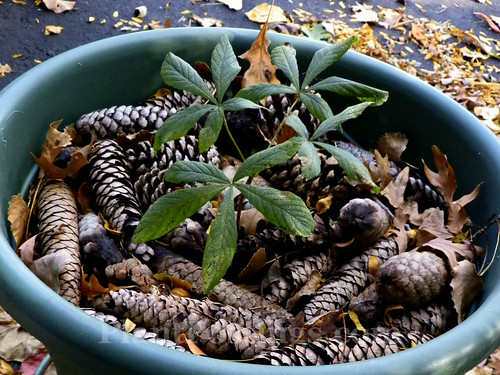
In addition, the foliage retained its green color well into mid-autumn, even as other trees around it had colored and lost their leaves. Both characteristics are common with Bottlebrush Buckeye, according to the Lady Bird Johnson Wildflower Center.
Unfortunately, I became busy with other things and neglected to take photos of the foliage when it changed color. I also neglected to take photos of the foliage in the spring, as it unfurled. All the more reason to focus on this tree for this year's "tree following" meme over at the Squirrelbasket.
(For an excellent post about the beauty of Buckeyes unfurling in springtime, check out Karin's post from last spring over at Southern Meadows.)

However, I did manage to look closely at the terminal bud. So much promise there!
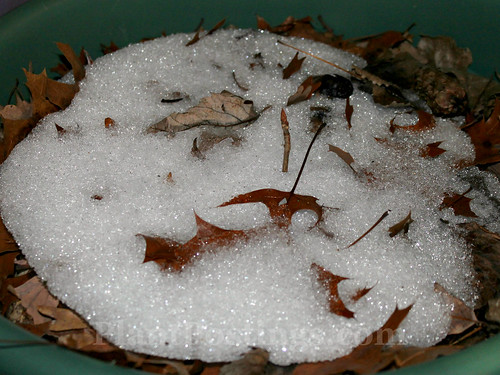
For winter, my little Buckeye is living in the garage, with warm layers of snow and leaf mulch for insulation. In a warmer climate, I'd leave it outdoors, but potted plants need a little help through our bitter winters.
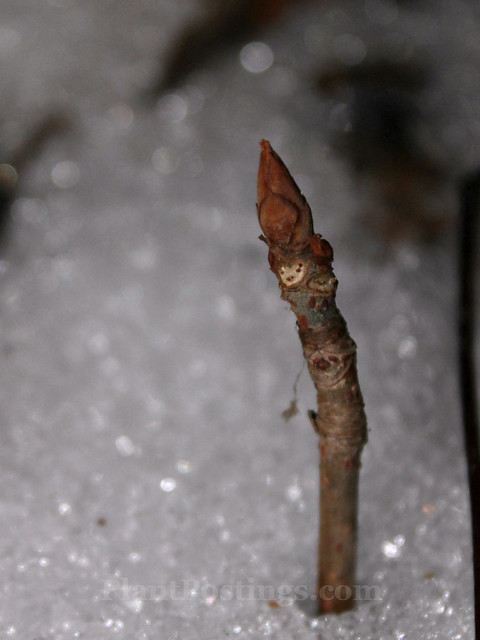
No matter what the species, I'll find a place for it in my garden. Buckeyes are considered good luck. Plus, the hummingbirds love the flowers, and one can never have too many hummingbird-attracting plants!
If/when this little treasure blooms, I'll have more clues about its identity. Join me near the seventh of each month for updates posted in the tree following meme. This will be a fun mystery to solve!
(Also, check out Dozen for Diana over at Elephant's Eye on False Bay.)
How timely! We found this plant growing in our yard last summer, and I thought it might be a type of chestnut, from the leaves. I'm unfamiliar with buck-eyes, so I didn't know they had similar leaves. Ours grew back again this summer, and is creating a small woody stem --it looks just like your photos. If it really is a bottlebrush buck-eye, I'm very excited!
ReplyDeleteFun! We'll have to compare notes. I secretly hope it's a Bottlebrush, because it would be so much easier to place in my garden. I remember Buckeyes from my early days in Indiana--they were much more common there. Please keep me posted, Cassi!
DeleteDid you ever see the Bottlebrush Buckeye at the Arboretun before they built the new visitor center? To say it was massive does not do it justice.
ReplyDeleteI vaguely remember this, although I spend much more time at the Arboretum now than I did years ago. Was it a hedge of Bottlebrushes? For some reason, the image is in my mind. :)
DeleteInteresting! It looks like cassava leaves here.
ReplyDeleteAh, yes, it does resemble Cassava. The palmate leaves are similar. I like the form of the branches and leaves of both plants.
DeleteI would like a Buckeye of my very own, but can only accommodate the shrubby one. I think that is the Red Buckeye. Very interested to see how your mysetery Buckeye turns out.
ReplyDeleteThe locations would be limited for us, too, if this turns out to be a large tree. If it's a Bottlebrush, which tends to be more of a shrub, we have more options. So, I'm secretly hoping for that. ;-)
DeleteI just love the foliage of a buckeye. Ones native to Texas also have a similar shape. Nice choice for tree following.
ReplyDeleteI like the foliage, too. And the flowers and the seeds. I think some of the same species are native and/or survive in both of our climates. They must be hardy trees. :)
DeleteHi Beth, that first one is really outstanding, but i think the colors are only there because of the cold. Keep warm and stay healthy.
ReplyDeleteYes, I'm still trying to figure out the interesting color on the early foliage. I'll be curious to see what happens this spring. I will try to stay warm and healthy. Thanks!
DeleteWhat a fun mystery and a stroke of good luck that it popped up in your garden! I'm so glad that you'll find space for it and will keep us posted as to it's true identity as it matures!
ReplyDeleteYes, it will be fun to follow this one. I'll have to be patient--it's not going to change much until April. ;-)
DeleteWhat luck to have a buckeye to watch. I can just imagine a squirrel coming to your garden with it's treasure and burying it in your mulch for a later snack only to find that it has sprouted. I would love to find a pop up in my garden.
ReplyDeleteI agree, Lisa--I'm picturing the little critter, too, who deposited the seed in the soil. ;-) I think I found another Buckeye seedling elsewhere in the garden, but I can remember where it was. Hmmm, maybe I'll find it this spring.
DeleteWhat a terrific find and great sleuthing on your part Beth! If it blooms you should be able to easily identify it but it is fun to figure it out beforehand. By the way, thanks for the link up.
ReplyDeleteYou are welcome, Karin. Thanks for sharing your beautiful images and descriptions! I can't wait for this one to bloom for the first time. I wonder how many seasons it will take?
Deleteinteresting mystery, tricky not knowing its size when you want to plant it in the garden. Looking forward to future developments and when mystery will be solved.
ReplyDeleteIt is tricky, Sue. I wonder if I'll even solve it this year. I don't think I'll know until it flowers, which could be a couple more years.
DeleteGood luck identifying the buckeye. For a few years I've admired a Red buckeye at the North Carolina Botanical Garden, but can't decide if there's room in my garden for one. They're beautiful though.
ReplyDeleteI agree, I'd be limited in locations for planting one of the larger species, like Ohio or Yellow Buckeyes. But I have a few spots in mind if it's a Bottlebrush. I think it might take a few years--until it flowers--to positively ID it, but we'll see.
DeleteGood luck with identifying it. I like all buckeyes but I think the garden is too dry for them.
ReplyDeleteThanks, Alain. We have a shady lot here, although some spots are very dry--especially in drought years. But as long as this tree is small, I'll keep it in the pot and water it, as needed. :)
DeleteExciting! Can't wait to see what it turns out to be :)
ReplyDeletePS - If it is a bottlebrush buckeye, I think you're in for a treat. I've heard they are fantastic plants for attracting butterflies :)
Me, too. :) Yes, I've heard about them attracting butterflies, too. They tend to bloom in midsummer--when Swamp Milkweed is blooming--so that would create great conditions for attracting more butterflies. Yay!
DeleteWhat a lovely little (at the moment) thing!
ReplyDeleteI particularly like the dark colouring on the leaves in those first few pictures.
I would have immediately thought "chestnut", but I didn't know you call them buckeyes in America.
I look forward to seeing more of this one :)
Yes, it's a tiny tree. :) One of the guesses from the Facebook group was that it could be a cross between a Horsechestnut (native to Europe) and some American species of Buckeye (I think Red).
DeleteWhatever you want to call it the leaf shape is so pretty. I would keep it, too. =) I have found that the stuff planted by birds and squirrels and the wind tends to become the most beautiful over time. (When they aren't too close to the fence that is)
ReplyDeleteI know: I find it a sweet little blessing from one of the garden critters. It was in the wrong place, bless their hearts, but a sweet gift nonetheless. ;-)
DeleteInteresting! This will be fun to follow. Are there any possible source trees in the neighborhood?
ReplyDeleteGood question, and that was raised by the Facebook group. I think I have seen Bottlebrush Buckeyes in the area. I'm not sure about other species. I'll have to be more observant this next growing season to sleuth it out!
DeleteI'll look forward to reading about this Buckeye over the following year. Red Horse Chestnut (Aesculus x carnea) is quite common over here in England, but I've never seen an actual Buckeye - although I'd like too.
ReplyDeleteGlad idea with the cones too, attractive and functional.
Yes one of the Facebook people thought it could be a hybrid--I think the one you mention. Apparently, that hybrid is common here in the Midwest U.S., as well. Buckeyes are more common east of us, but we do have some here. I agree--they're beautiful trees!
Deletegood luck and hummingbirds!
ReplyDeleteWhat more could we ask for?
Our edible banana has plans to take over the world - as a gift from a friend - I have no idea quite how BIG it is going to get. With a second sprout coming up as well
Thanks! Yes, what more could we ask for?! Oh, that would be fun to have a Banana tree! I'm jealous!
DeleteI'm watching a whack of Japanese Maple seedlings - I've got at least 5 seed producing plants and each new plant seems to be replicating themselves in absolute unique ways - different leaf shapes, colours, form, growth pattern. Who knows, this maybe something completely new, perhaps a Aesculus stetenfeldii!
ReplyDeleteHow fascinating about the unique Acer seedlings! LOL, re: the Aesculus. I don't have any other Buckeyes on my lot (maybe some tiny ones in the woods?), so it's probably the seed from a neighbor's tree. I can't wait to find out which species. :)
DeleteLucky you! They are nice trees with great color, big too. Maybe your squirrel was planning for his future family.
ReplyDeleteYes, some of the species (Yellow and Ohio) are quite large. If that's the case, I may plant it toward the back of the property. If it's a Bottlebrush, which is shrub-size, I have more options and several locations in mind. :)
DeleteThe leaf colouration on that first photo is just lovely. I don't know anything about buckeye's, but I'm intrigued to see what the final verdict will be.
ReplyDeleteYes, the leaf coloration is stumping me a little bit. I can't seem to find any other photos of Buckeyes with that color pattern. If I could, it would make the identification so much easier!
DeleteI always love a nature mystery..... And finding an answer
ReplyDeleteMe, too. And now I'm feeling impatient to find the answer. But it will have to wait until the tree flowers--which could take a couple of years. I have a suspicion it's a Bottlebrush, though, the more I read about them.
DeleteI never get such special seedlings. Looking forward to following your little seedling Beth.
ReplyDeleteI love the colouring in the top picture. Good luck in getting a proper ID.
I seem to get tons of Maple seedlings, but few other trees. So this is a special gift. :) Thanks for the good luck wishes!
DeleteShe grew up these "mystery" in the garden and I wonder final solution to her. Regards.
ReplyDeleteYes, it's a good little mystery, which might take some time to solve. I'll be thrilled when this tree blooms, for many reasons!
DeleteYour plant has beautiful foliage. I look forward to seeing the mystery finally resolved. We have bottlebrush buckeyes that grow wild in this area, and yours definitely could be one.
ReplyDeleteYes, the foliage is attractive. I was pleased. Gosh, I hope it's a Bottlebrush. :)
DeleteVery cool! What a great gift from Mother Nature. :o)
ReplyDeleteYes, Mother Nature was generous with this one! I hope the little tree will grow and thrive until I can find an appropriate place for it. :)
DeleteHope your gift from Nature survives the winter. Won't it be fun to finally determine exactly which species it is? Happy new year!
ReplyDeleteI hope so, too. It's in the garage, and I'll probably water it every couple of weeks on the warmer days. It will be fun to solve this mystery!
DeleteOh, fun! It sounds like you have a few clues, and hopefully this year you'll be able to solve the mystery as the plant grows larger!
ReplyDeleteIf/when it blooms it should be relatively easy to solve. I hope that happens this summer, but we shall see...
DeleteI am really looking forward to seeing more of your Buckeye as I hardly see them here....and flowers that hummers love....yes that is a prized flower i want to see! A special tree that was gifted by nature...bliss!
ReplyDeleteJust noticed this comment, Donna. Sorry for the delay. Sometimes I miss them in my haste to post anew. ;-) I'm excited about this little tree, too. Soon I'll move it outside to begin the transition to spring!
Delete